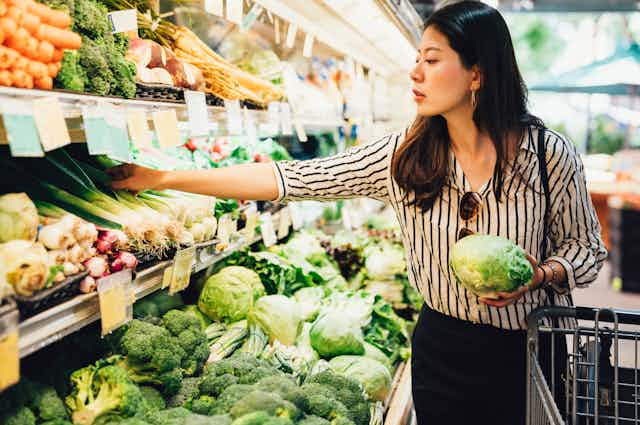An affordable daily diet has edged too far away for many Australians. Food prices have risen sharply since 2021, fuelling cost of living pressures and food insecurity. Some 3.7 million Australian households experienced food insecurity in 2023 – 10% more than in 2022.
Food prices have always been a challenge for many Australians. This is especially true for people on low incomes, refugees, people living in rural areas, single mothers, and people with disability. A basic healthy diet can cost city-dwelling families who are doing it toughest roughly one-third of their income.
So what is the Australian government doing to ease the cost of a supermarket shop? Let’s take a look.
First, how much have food prices increased, and why?
Food prices peaked in December 2022, with an average shopping basket costing 9.2% more than in 2021. Although food prices have eased since that peak, they remain significantly higher now compared to before the pandemic.
Almost all food categories have been hit, but many healthy foods appear to have increased in price at almost double the rate of discretionary (unhealthy) foods.

The COVID pandemic, climate events such as floods and bushfires, and international conflicts have all contributed, to varying degrees. These events have placed undue pressure on food supply chains through food shortages, increased fuel, energy and transport costs and a shortage of workers from farm to fork.
Big supermarkets have also been scrutinised recently. In Australia, supermarkets can set prices, with little transparency. This is against a backdrop of one of the most powerful and concentrated grocery sectors in the world, severely limiting competition.
Claims of supermarket price gouging have inspired public outrage, particularly given the two supermarket giants each pocketed more than A$1 billion in profits in 2022-2023.
Read more: Are you living in a food desert? These maps suggest it can make a big difference to your health
So what is the government doing to ease the pressure?
The government’s Standing Committee on Agriculture undertook an inquiry into food security in Australia in 2023, and came up with 35 recommendations. While many of these recommendations may indirectly influence food prices, only one explicitly addressed food prices: to provide subsidies for remote community stores so fresh food can be sold at an affordable price. These recommendations are yet to be implemented.
At the end of 2023, the Senate Select Committee on Supermarket Prices was established to “inquire into and report on the price setting practices and market power of major supermarkets”. Submissions to the inquiry recently closed, with the final report due in May.
In early 2024, the government announced an independent review of the Food and Grocery Code of Conduct to ensure the grocery retailers and wholesalers are dealing fairly with suppliers. Although not specifically focused on the shelf price of food, a fairer deal between retailers and suppliers may flow to lower prices for consumers.

Most recently, the Albanese government formally issued a directive to the Australian Competition and Consumer Commission (ACCC) to carry out a 12-month investigation into supermarket prices. This will have more teeth than other inquiries, allowing the ACCC to use legal powers to gather information, including from the supermarkets themselves.
If wrongdoing is uncovered, the ACCC has the power to take the supermarkets to court. The pressure from the inquiry may also lead to supermarkets voluntarily lowering food prices, in a similar way to previous inquiries.
Read more: The cost of living is biting. Here’s how to spend less on meat and dairy
What are other countries doing?
In Greece, the government has temporarily forced supermarkets to reduce prices on basic products. For example, the price of at least one type of bread would be lowered and advertised to shoppers at this lower rate. The Greek government has also provided low-income households with a monthly allowance to support grocery costs, among other measures.
The French government has worked with the food sector to secure a commitment from 75 companies to cut their prices. It has also promised regular price checks at supermarkets to ensure prices fall, with financial penalties if they don’t.
In Spain, the value added tax on basic foods, such as fruits, vegetables, pasta and cooking oils, has been eliminated or lowered. Government tax revenue will be reduced for these items, but retained for other non-basic foods (similar to the GST in Australia).
What next for Australia?
The multi-year food price crisis has revealed the vulnerability of our food system. We need to recover from where we are, but we must do so in a way that ensures a more resilient food system with stable food prices over time.
While it’s too early to know what will come of the various food price inquiries, the government is and should continue to provide general cost-of-living support. The recent revised Stage 3 tax cuts are an example of increasing the flow of money to those who need it most, easing pressure at the supermarket checkout.
Read more: Trying to spend less on food? Following the dietary guidelines might save you $160 a fortnight
Further support for vulnerable households could be implemented by expanding existing social safety nets through increasing income support payments.
The fate of food prices in Australia is, at least for now, uncertain. But one thing is for sure. Unless the government steps up to ease the pressure, too many Australians will keep struggling to put food on the table.

